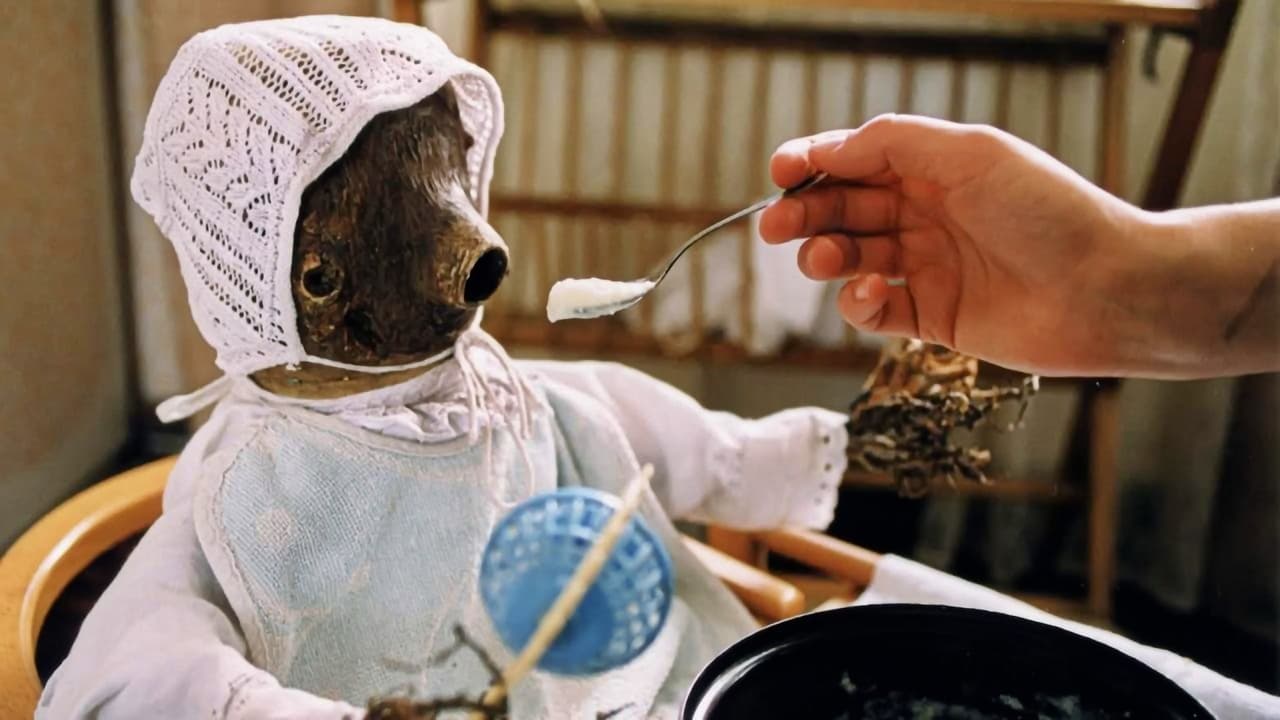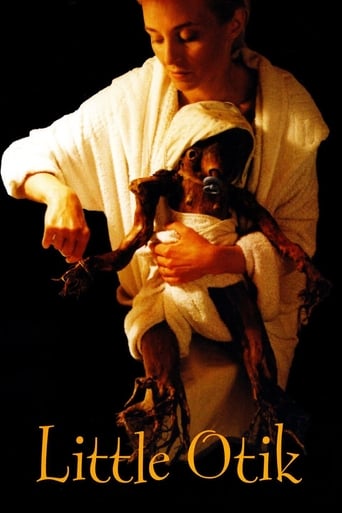

After watching Jan vankmajer's "Otesánek" ("Little Otik" in English), all that I can say is "What the hell did I just watch?" Don't get me wrong, it's a pretty good movie, just one of the more twisted movies out there. Jan Hartl and Veronika ilková play an infertile Czech couple who adopt a tree stump as a baby...only to see it come to life and start eating everyone who crosses its path! Yes, it's mainly a black comedy from the master of weird animation, but while watching the movie I got the feeling that it was also looking at the residual effects of the Soviet occupation, as people eat rotten-looking porridge. It also seemed as though the girl befriended Otik out of a feeling of alienation from her parents (the same sort of reason why the children in Stephen King's novels join up with each other). Whatever the case, I liked the movie. But just remember, it's a VERY disturbing movie.
... View MoreA fairy tale, that name, and my upbringing, always made me imagine not so dramatically the savage that really means to be eaten by an wolf, or a gigantic baby live stump, after all everybody would be leaving happily ever after the Wolf belly was cut by some savior, so the tragic end was not so tragic after all, the spell would always be cast off. One of the matter is, Folk tales although morally intended, could somehow as well ending up have an inconsequential value to whatever force, or miss- action that drove the main characters down that road for whatever that it is was trying to say, therefore loosing their original intention and it's poetical and moral intentions to a happily ever after ending.Folk tales is a better name for what it is intended, to have our imagination protected like that, or for the children you could say, looses an important aspect of beauty, of actually dealing with the real world in ways that are much more intriguing than the ones that we have been classically presented for the last century and so on, and that it was just blown into my face, how much has infected my own imagination, in realizing I can only imagine the characters being eaten up in a cartoon kind of way, where they are not on the ordeal of the tragic to be experienced. I remember receiving this book when I was kid about this giant, I confess that I don't remember the exact plot of what happened, there are gardens, roses, and he dies, the sadness of that story is not exactly because he dies, but the poetry contained in there, it was something that moved me, that made my whole day ethereal, Things were different that day and tasted different, that experience made my life bigger. Of course, there are measures for what and how it can be shown, I am not here advocating to spook children out of their pajamas and cookies, they are so very sensitive to what it is given to them, but their imagination are much more than princesses and princes fairy tales, and that it is my point about that. The other point it is to become friends with the monster. "Oh, please don't go—we'll eat you up—we love you so!" Where the Wild Things Are So the plot of the book it is simple, and if you read the synopses you will know, what the movie is all about. A contemporary folk tale. "When a childless couple learn that they cannot have children, it causes great distress. To ease his wife's pain, the man finds a stump in the backyard and chops it and varnishes it into the shape of a child. However the woman takes the root as her baby and starts to pretend that it is real. When the root takes life they seem to have gained a child; but its appetite is much greater than that of a normal child." (it is funny how whoever writes plots always want it to make very intriguing, so you can be drawn by the riddle of the mystery that it is left upon the lines). In this case is kind of ludicrous.The synopses is also the plot of the movie. You could say that all the plots can be done one Thousand times, and what it is actually inside the sandwich that counts. But it is not exactly how many films are made, so many rely so much on the plot, and those mechanisms really give the whole energy for things to happen. But for this movie, things are driven in a different manner, what happens in this flow, inside the story and how it is told that really matter, what it is added inside the sandwich, the journey, the world created, the actual experience of watching it, can only be told in the end, as of while it was happening you couldn't really understand it. This assumption has a meta-linguistic force in the movie, only Alzbetka finds out about the tale, and only she is able to have some control over what it is happening.Jan Svankmajer adds to the sandwich black humor, surreal Kafkian situations, the old pedophile from Family Guy is there, Strong characters, the food obsession in many many levels, the never ending desiring and consumption driving we can have, how we can be socially driven by the assumption and pressure of that imaginative other's can put upon on what we are, the "mother" completely lost and hysterical on her desire of having a baby, our responsibility as the maker of our own nightmares, our own personal jails, the funny behavior of the cops, and most amazingly to me the thin and amazing thread that he makes this whole world stand upon something we can easily recognize as reality and complete dreamlike surreal experiences, all at the same time.His shorts movies are inside the story as well, as adds, we can see that the Avante-Garde can quickly be absorbed and consumed into the main stream. A good example examples was Gummo, that turned into Beasts of The Southern Wild, but anyway... Of course, there is the airplane theory, that after it was invented, airplane inventors start to pop up elsewhere, but I am not really sure it is exactly like that. In a folk tale, I think we are kind of obliged to try to answer this question, what it is the physiological moral power that this story has?I would say, that it is telling that people (grown ups) and society, can be amazing misunderstood cry babies that are ought to consume bluntly everything it faces, so be caution with your desires. Maybe it is something else. But I think it is about this egotistic, anthropomorphic view of the world with never ending consequences and it's folk tale consequences.
... View MoreI was blown away by every aspect of this film! The husband of a couple, frustrated at not being able to conceive, chops up a piece of wood in the image of a child and presents it to his wife. But this modern day Geppeto is in for a very dark surprise. At first, his wife treats the piece of wood as a live child, and the husband senses a problem and intends to take the 'child' away from her. But she is hooked. And soon, the "child" takes on a life of it's own.What was fascinating to me was the story within the story....a real child in the same building as the couple senses something is not right, discovers the secret (which is very disturbing to watch), and finds a fairy tale among her books which tells the story of what is happening. You see clips of her reading the story as it unfolds....very creative film-making, inventive storytelling and great cinematography! Not recommended for young children, even though there are children in it....it's way too disturbing!!
... View MoreThe worldview that drives this movie is the notion that you cannot escape the stories of the past. Ruiz makes movies with this point, especially one I saw recently, "Geneologies." In this view, the teller doesn't capture a story, it is the other way around. There are only so many stories, and when one captures you, it will engulf you, only to be possibly bested by a stronger one.That's the story within this little movie, done well enough for TeeVee, I suppose. But it is also the story about why this and all Czech cinema is so defeatist. Yes, I know the Czech republic is a tiny nation, so we shouldn't expect much. But compared say, to New Zealand, the contrast in imagination is striking. Sure, they were bludgeoned by successively thuggish occupiers, but look at Polish cinema. Some are truly lyrical and life-altering things, no? What's happened with this movie: it has been captured by the larger Czech arc of defeat. That larger arc drives this and completely overtakes the best efforts of Svankmeir, who in a few earlier projects really seemed to have some promise as a visual artist if not a long form storyteller.The movie's story, since you likely won't see it, is of a couple who out of emotional need take a piece of yard waste as an infant, and he grows too big for his situation, eating everything he encounters. Meanwhile, a little girl in the same building follows that larger story by reading the "original" in a children's book. So she knows the score, and how it will end.Ted's Evaluation -- 2 of 3: Has some interesting elements.
... View More